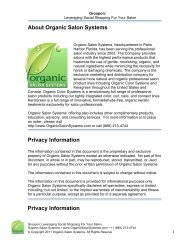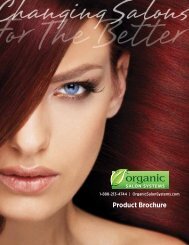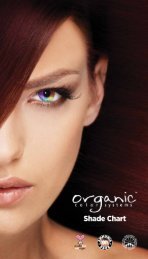Technical Assistance: 1-888-213-4744 - Organic Color Systems
Technical Assistance: 1-888-213-4744 - Organic Color Systems
Technical Assistance: 1-888-213-4744 - Organic Color Systems
You also want an ePaper? Increase the reach of your titles
YUMPU automatically turns print PDFs into web optimized ePapers that Google loves.
<strong>Technical</strong> <strong>Assistance</strong>: 1-<strong>888</strong>-<strong>213</strong>-<strong>4744</strong> ext: 902 | Online Ordering: organicsalonsystems.com<br />
<strong>Organic</strong> <strong>Color</strong> <strong>Systems</strong> vs. Other Non-Ammonia Brands<br />
Until recently, <strong>Organic</strong> <strong>Color</strong> <strong>Systems</strong> was compared<br />
to hair <strong>Color</strong>s containing ammonia and the difference<br />
was obvious and easy to understand. As a result of<br />
the increasing number of non-ammonia hair <strong>Color</strong>s<br />
coming onto the market, it is important to understand<br />
the difference between <strong>Organic</strong> <strong>Color</strong> <strong>Systems</strong> and<br />
these <strong>Color</strong>s as well.<br />
To fully understand this, it is vital to understand<br />
ammonia’s role in a hair <strong>Color</strong>.<br />
The primary function is to raise the pH of the hair<br />
sufficiently so as to open the cuticle and allow the<br />
<strong>Color</strong> to enter the cortex of the hair. Depending on<br />
the percentage of ammonia in each <strong>Color</strong> this can<br />
vary as to how high the pH of the hair is taken. The<br />
more ammonia there is in the product, the higher the<br />
pH of the hair. This is a tried and tested, but outdated<br />
method (as proven by the number of companies<br />
now launching <strong>Color</strong> ranges without ammonia), as<br />
the cuticle is generally expanded to such an extent<br />
as to allow the <strong>Color</strong> to easily enter the cortex. The<br />
secondary function is that when mixed with peroxide,<br />
ammonia neutralizes the existing <strong>Color</strong> pigments to a<br />
greater degree.<br />
This is a tried and tested (but outdated method, as<br />
proven by the number of companies now launching<br />
<strong>Color</strong> ranges without ammonia), as the cuticle is<br />
generally expanded to such an extent as to allow the<br />
<strong>Color</strong> to easily enter the cortex. Unfortunately there<br />
are three main side effects:<br />
1. At the same time that the <strong>Color</strong> is swelling the<br />
cuticle to easily enter the cortex, there is significant<br />
protein and moisture loss. This is how the hair is<br />
damaged during <strong>Color</strong>ing when using an<br />
ammonia <strong>Color</strong>.<br />
2. The pH of the hair is raised to such an extent<br />
by the ammonia that it is physically impossible<br />
to return it to its ideal pH after <strong>Color</strong>ing. This<br />
means that the cuticle remains open, the hair<br />
continues to lose protein and moisture and<br />
there is also an increased risk of <strong>Color</strong> fade.<br />
3. As a result of the cuticle remaining open, the<br />
percentage of pigment in the <strong>Color</strong> needs to<br />
be as high as possible. This is necessary as a<br />
relatively high percentage of the <strong>Color</strong> will be<br />
lost when rinsing off at the backwash. Plus, due<br />
to the greater neutralisation of the pigment by<br />
the ammonia-peroxide mix, a higher pigment<br />
percentage is required.<br />
More and more companies are now removing<br />
ammonia from their hair <strong>Color</strong>s. This is commendable,<br />
as ammonia is an extremely harsh chemical and does<br />
not need to be in hair <strong>Color</strong>.<br />
Unfortunately the vast majority of these <strong>Color</strong>s<br />
have merely removed ammonia from the <strong>Color</strong> and<br />
replaced it with an ingredient called ethanolamine,<br />
but the same three side effects mentioned above still<br />
apply. The rule that the more ammonia there is in the<br />
<strong>Color</strong>, the higher the pH applies to ethanolamine as<br />
well. All they have achieved is to remove ammonia<br />
from their <strong>Color</strong>s; they haven’t managed to decrease<br />
the pH that these <strong>Color</strong>s take the hair to.<br />
The key difference with <strong>Organic</strong> <strong>Color</strong> <strong>Systems</strong> is<br />
that the base of the <strong>Color</strong> (the main ingredient) is not<br />
only alkaline, so it raises the pH of the hair, but it is<br />
also a conditioning agent, so it softens the cuticle at<br />
the same time. This softening process means that<br />
<strong>Organic</strong> <strong>Color</strong> <strong>Systems</strong> is able to work at a far lower<br />
pH and is a far gentler way to <strong>Color</strong> the hair. As a<br />
result, the three side effects mentioned above don’t<br />
apply to <strong>Organic</strong> <strong>Color</strong> <strong>Systems</strong>.<br />
<strong>Organic</strong> <strong>Color</strong> <strong>Systems</strong> does contain ethanolamine.<br />
It is used because the base isn’t sufficiently alkaline<br />
to open the cuticle enough for the <strong>Color</strong> to enter the<br />
cortex. Ethanolamine is therefore used to increase<br />
the pH enough so that this can occur. <strong>Organic</strong> <strong>Color</strong><br />
<strong>Systems</strong> uses oleic acid in the formulation specifically<br />
to neutralize any residual ethanolamine.<br />
better hair, better result, better you Page 5







